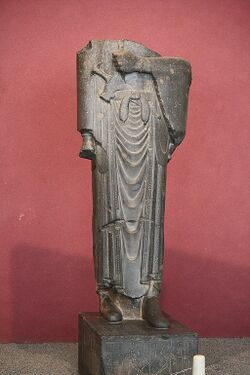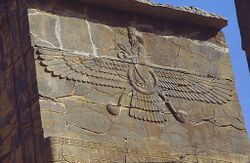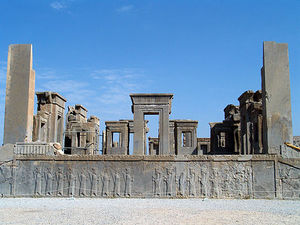What Gods Did Darius "the Great" Worship
Darius I (ruled 522-486 BC), often referred to as Darius “the Great,” is the best known of all the Achaemenid Persian kings for several reasons. To those familiar with Darius the Great today, he is known primarily for his military endeavors as the Persian king who started the Greco-Persian Wars (499-449 BC) by suppressing the Greek Ionian Revolt. Darius I then ordered the invasion of mainland Greece, although that ended in the Persian defeat at the Battle of Marathon in 490 BC. Darius I was the father of Xerxes I (reigned 486-465 BC), who was the Persian king who led the Persian army for the remainder of the Greco-Persian Wars, but more importantly Darius I is known for several other non-military endeavors that helped make the Achaemenid Empire the most powerful political entity of the period. He initiated several internal reforms that made the empire run more efficiently and was instrumental in the construction of an ancient Suez Canal that linked the Mediterranean and Red seas.
Darius I was also the primary Persian king who commissioned the building of the capital city of Persepolis. An examination of the inscriptions that accompany many of his building activities reveals that Darius I was a pious man and an early follower of the religion that would become known as Zoroastrianism, but he was also quite tolerant and allowed other religions to flourish within his empire.
Contents
The Achaemenid Empire
The Achaemenid Empire is quite unique among other ancient empires because it seemingly came out of nowhere. The empire began with humble origins among a dynasty of semi-nomadic Persians known as the Achaemenids, who were of little consequence in the region until one of their kings named Cyrus “the Great” (ruled 559-530 BC) led them to conquer the most powerful kingdoms in the area including Media, Lydia, and finally Babylonia in 539 BC. [1] Since the Achaemenid Persians were a semi-nomadic people who were suddenly rulers over a large, urban population, they adopted many elements of Near Eastern civilization, including models of kingship and royal ideology. Mesopotamian royal ideology can be traced back to the Akkadians, particularly King Sargon of Akkad (reigned ca. 2340-2284 BC), who took the royal epithet “he who rules the Four Quarters.” Sargon’s grandson, King Naram-Sin (ruled ca. 2254-2218 BC), followed suit by assuming the title “King of the Four Quarters,” which then established a precedent among most of the kings in Mesopotamia. [2]
The concept of the king as ruler of the universe was adopted by Cyrus and the Persians when he officially proclaimed himself as such on the famous Cyrus Cylinder, which was essentially a commemoration of his conquest of Babylon. The cylinder states: “I am Cyrus, king of the world, great king, legitimate king, king of Babylon, king of Sumer and Akkad, king of the four rims of the Earth.” [3]
Achaemenid Persian Religion
It is important to understand the origins of Achaemenid Persian royal ideology because in the ancient Near East political ideology was intricately intertwined with religion. The king was appointed by the gods to carry out their wills and usually was considered the high priest of any particular dynasty’s primary god or goddess so therefore any understanding of what gods Darius I worshipped can only be understood within the realm of religion.
The Achaemenid Persians followed a religion that can best be described as an early form of Zoroastrianism, or proto-Zoroastrianism. [4] Zoroastrianism was a dualistic religion where many different gods were acknowledged, both good and evil, but the chief god, Ahuramazda, was the primary object of veneration. Besides being the source of all earthly good and purity, Ahuramazda was also associated with the sun and fire.
Following in the dualistic aspects of Zoroastrianism, it was the duty of the Achaemenid kings to promote the truth or asha over the lie or drugh, which was the result of the evil god Angramianu’s influence in the world. [5] Although Cyrus and the early Achaemenid kings worshipped Ahuramazda as their primary god, primary sources from the period show that they were willing to accept other gods.
Besides outlining the Achaemenid Persian concept of royal ideology, the Cyrus Cylinder details how Cyrus restored the cult of Babylon’s most important god, Marduk. The text reads: “The worship of Marduk the king of the gods, he (Nabonidus) changed into abomination, daily he used to do evil against his city . . . When I entered Babylon as a friend and when I established the seat of the government in the palace of the ruler under jubilation and rejoicing, Marduk, the great lord, induced the magnanimous inhabitants of Babylon to love me, and I was daily endeavouring to worship him.” [6]
The details of the text are probably not entirely factual – it seems difficult to believe that the Babylonian King Nabonidus would have defiled the god of his city – but it was politically important for the conquering Achaemenid king to patronize Marduk to some extent. [7] The concept of religious tolerance for political gain established by Cyrus was followed and expanded by Darius the Great during his long reign.

Darius the Great and Religion
Among all the Achaemenid Persian kings, Darius the Great left the most inscriptions and monuments throughout the empire, which have helped modern scholars better understand his religious ideas. There remain many questions concerning how Darius I came to the throne since he was from a collateral branch of the royal family, leading many to believe that he usurped the crown from his predecessor Cambyses’ brother. [8] Darius I’s questionable legitimacy, combined with his long rule, may have played significant roles in the king’s increased piety, or at least the perception he wanted to create of his piety.
Inscriptions from the Persia sites of Behistun, Naqsh-i-Rustam, Susa, and Darius I’s capital of Persepolis – written in the languages of Old Persian, Elamite, and Akkadian in the cuneiform script – all attest to his allegiance to Ahuramazda. Although little theology is related in the texts, it is clear that Ahuramazda was the sovereign’s primary and only mentioned deity. An inscription from Persepolis is characteristic of all Darius I’s texts from Persia:
“Saith Darius the King: May Ahuramazda bear me aid, with the gods of the royal house; and may Ahuramazda protect this country from a (hostile) army, from famine, from the Lie! Upon this country may there not come an army, nor famine, nor the Lie; this I pray as a boon from Ahuramazda together with the gods of the royal house. This boon may Ahuramazda together with the gods of the royal house give to me!” [9]
Based on the texts from Persia, it is clear that Darius the Great was a pious follower of Ahuramazda, but a number of texts from outside of Persia show that the king, like Cyrus before him, was willing to acknowledge other peoples’ gods. Darius the Great gave particular attention to Egypt, where three stelae inscribed in Egyptian hieroglyphs and Elamite and Akkadian cuneiform demonstrate that he complete a canal that went from the Red Sea to the Nile River thereby giving access to the Mediterranean Sea. The language on the Suez stelae is very similar to that on a statue of Darius the Great that was discovered in the ruins of Susa in 1972. The statue, which was probably originally in Egypt, is important for several reasons. It is the only known example of Achaemenid Persian royal statuary, but equally important are the inscriptions on the robes of the statue, which were in Egyptian hieroglyphs and Old Persian, Elamite, and Akkadian cuneiform.
The Egyptian language inscriptions describe Darius the Great as “born of Atum, the living image of Re” and that “Neith gave to him her bow that was in her hand to throw don all his enemies.” [10] Atum and Re, like Ahuramzada, were both Egyptian solar gods associated with kingship, while Neith was a goddess who was particularly venerated by the Egyptian dynasty the Achaemenid Persians vanquished. Clearly Darius the Great was employing a bit of the same political strategy Cyrus used when he patronized the Marduk cult after he conquered Babylon. Interestingly, the cuneiform texts on the statue make no mention of the Egyptian deities and instead invoke the Persian/Zoroastrian god in typical formulaic fashion.
“The great god Ahuramazada who created this earth, who created the sky and the below, who created man, who created happiness for man, who made Darius king, here is the statue of stone that Darius the king ordered it made in Egypt in order that in the future humanity would see and know that a Persian ruled Egypt. I am Darius, great king, king of kings, king of nations, king of this great earth, the son of Hystaspes, the Achaemenid. Darius the king said, ‘Ahura Mazda protects me and makes everything for me!’” [11]
Conclusion
Greek historians such as Herodotus often depicted Darius the Great as a bloodthirsty, amoral tyrant who had almost as little regard for his own subject as he did for his enemies. An examination of the Persian sources reveals that this view is the result of Hellenic bias because Darius was actually a pious king. He believed very deeply in the religion of his people as evidenced by the numerous inscriptions where he gave praise to his primary god, Ahuramazda.
Beyond Persia, especially in Egypt, there is ample evidence that Darius the Great was quite tolerant toward his conquered subjects’ religions and even took the time to acknowledge and patronize their gods. There is no doubt that part of his patronage of non-Persian deities was due to political considerations, but there is also no doubt that Darius I was a religious man. Darius the Great placed Ahuramazda above all other gods and goddesses but was willing to accept foreign deities that were close enough to his own god thereby being one of the first people in history to effectively mix politics and religion.
References
- ↑ Briant, Pierre. From Cyrus to Alexander: A History of the Persian Empire. Translated by Peter T. Daniels. (Winona Lake, Indiana: Esenbrauns, 2002), pgs. 31-44
- ↑ Frankfort, Henri. Kingship and the Gods: A Study of Ancient Near Eastern Religion as the Integration of Society and Nature. (Chicago: University of Chicago Press, 1978), p. 228
- ↑ Pritchard, James B, ed. Ancient Near Eastern Texts Relating to the Old Testament. 3rd ed. (Princeton, New Jersey: Princeton University Press, 1992), p. 316
- ↑ Clark, Peter. Zoroastrianism: An Introduction to an Ancient Faith. Brighton, United Kingdom: Sussex Academic Press, 2001), pg. 56
- ↑ Malandra, William W. An Introduction to Ancient Iranian Religion: Readings from the Avesta and Ancient Achaemenid Inscriptions. (Minneapolis: University of Minnesota Press, 1983), pg. 13
- ↑ Pritchard, James B, ed. Ancient Near Eastern Texts Relating to the Old Testament. 3rd ed. (Princeton, New Jersey: Princeton University Press, 1992), p. 451
- ↑ Krebsbach, Jared. “Achaemenid Persian Patronage of Egyptian Cults and Religious Institutions in the Twenty-Seventh Dynasty: A Study of Political Acumen in the Ancient World.” In Religion in the Achaemenid Persian Empire: Emerging Judaisms and Trends. Edited by Diana Edelman, Anne Fitzpatrick-McKinley and Philippe Guillaume. (Tübingen: Mohr Siebeck, 2016), p. 330
- ↑ Briant, p. 102
- ↑ Kent, Roland G. Old Persian: Grammar, Texts, Lexicon. Second Edition. (New Haven, Connecticut: American Oriental Society, 1953), p. 136
- ↑ Yoyette, Jean. “Les Inscriptions Hiéroglyphiques Darius et l’Égypte.” Journal Asiatique. 260 (1972) pgs. 254-6
- ↑ Vallat, François. ““Les textes Cuneiformes de la statue de Darius.” Cahier de la Délégation Archéologique Française en Iran. 4 (1974) pgs. 161-4


